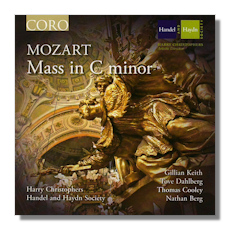
The Internet's Premier Classical Music Source
Related Links
- Mozart Reviews
- Latest Reviews
- More Reviews
-
By Composer
-
Collections
DVD & Blu-ray
Books
Concert Reviews
Articles/Interviews
Software
Audio
Search Amazon
Recommended Links
Site News
 CD Review
CD Review
Wolfgang Mozart

Mass in C minor "Great", K. 427
- Gillian Keith, soprano
- Tove Dahlberg, mezzo-soprano
- Thomas Cooley, tenor
- Nathan Berg, bass-baritone
Handel and Haydn Society Chorus & Orchestra/Harry Christophers
Coro COR16084
Mozart wrote 18 masses. Two are unfinished – including this one, the "Great" Mass in C minor, K427. Significantly, it was written without a commission from patrons either in the city of his birth, Salzburg, which he had just left (in 1781) after years of mistrust of Archbishop Colleredo and dissatisfaction with his life there. Or in Vienna. It was a Mass of thanksgiving for his marriage to Constanze (neé Weber) and the prospective arrival of their first child. And a joyous work it is too. The first time it was performed (albeit probably only incomplete) Constanze sang the soprano arias.
There are other circumstantial reasons for its composition – not least as an appeasement to Leopold (Mozart's father). Yet from some of K427's musical properties we can be sure it meant a great deal to Mozart. The scale of the Mass in C minor is large… four soloists; a chorus singing in mostly five, sometimes eight, parts; and an orchestra stretching to trumpets, trombones and drums. These all but confirm that Mozart had other motives for writing it. These are likely to include, specifically, Mozart's recent exposure to the music of Bach and Handel immediately after arriving in Vienna. And, more generally, a new or renewed interest in counterpoint. One might go further and speculate that – newly released from the constraints of Colleredo's Salzburg – Mozart felt able to and justified in extending his own compositional powers in the context of those whom he considered also great.
So Harry Christophers and the Handel and Haydn Society Chorus and Orchestra with soloists Gillian Keith (soprano), Tove Dahlberg (mezzo-soprano), Thomas Cooley (tenor) and Nathan Berg (bass-baritone) have a difficult balance to achieve: that between magnificence and gravity as befit the scale of an otherwise conventional mass as conceived by Mozart on the one hand. And a respect for – even a reflection of – the probably more intimate circumstances in which Mozart wrote it; and left it unfinished… we have nothing of the second half of the Credo (from the wonderful Crucifixus) or the Agnus Dei. It's also necessary for the performers to weigh the absence of a dramatic conclusion at the Benedictus with an awareness of the work's architecture as Mozart obviously did conceive it. This the musicians do very well. Each movement, indeed each passage, is played for its own sake, in its own right. As if the torso did have a head and all its limbs. This is surely the right decision. K427 is not a curiosity. The implication, perhaps (certainly this is what Lindsay Kemp suggests in the liner notes), is that Mozart felt he had said all he had to say and need not "drain himself" further.
Such balances are achieved both by close attention to detail… the singing and playing are precisely conceived, and meticulously executed. And by Christophers' overall vision of the work. Neither too dramatic nor too "relaxed". There is a splendid forward momentum from start to (defective) "finish", which, while not supplying that finish, does suggest that the work is not quite so defective. That the CD ends with a very long and gently fading burst of audience applause may help here. The soloists are good. The chorus on top form; and the orchestra full of energy and grace.
The CD comes with a short but pithy essay on the origins on the Mass and brief background to the performers, the text of the Mass in Latin and English, usefully indicating which singers participate in which numbers. The acoustic (of Symphony Hall, Boston, Massachusetts) is resonant but homely. Helmuth Rilling's account on Hänssler Classic (98.227) with the Stuttgart Bach Collegium and Gächinger Kantorei Stuttgart and soloists would be a good first choice. But for their vivid sense of urgency, immediacy and melodious uplift within the bounds of comfort and certainty which Mozart clearly felt when writing this celebration of personal and musical kinds, this new CD from Coro is worth a look.
Copyright © 2010 by Mark Sealey.





















